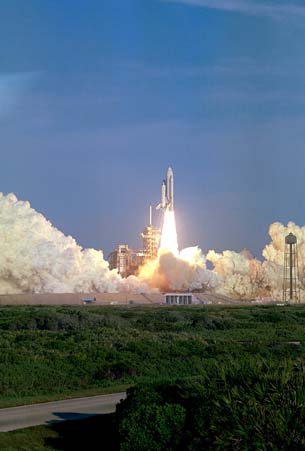May 1, 2011
By Steve Robbins
 |
As I sit at my desk writing this editorial, the newswire has just informed us that the remaining three space shuttles have been auctioned off to the Smithsonian Institution in Washington, DC, the Kennedy Space Center Visitor Complex in Cape Canaveral, FL and the California Science Center in Los Angeles. It’s a defining moment for the space program, as the last shuttle launch will happen this summer and then the United States will be without an operating vehicle to service the International Space Station or perform other scientific duties in space.
I grew up before we had put a man in space. The Russians went first with Yuri Alekseyevich Gagarin. When Alan Shepard, in his Mercury spacecraft, was sitting on top of a Redstone rocket, I was enthralled. Being nine years old, my best friend and I decided to write NASA about joining the space program. Unbelievably, someone at NASA actually wrote us back and included a lot of pamphlets about the program and becoming an astronaut. In 1961 the Mercury spacecraft had 120 controls, including 55 electrical switches and 35 mechanical levers.
About 25 years later Mobile Computing Magazine published a story on the back up computer for the space shuttle. It was a GRiD laptop that was attached via hook-and-loop to the main instrument panel. It had exponentially more compute power than the multiple redundant computers in the shuttle’s main computer system. Today, the same basic design is running the computer systems of the original shuttle. It has been upgraded over time but, by today’s standards, it’s a dinosaur.
More Tech, Less Motivation
It’s sad to see the space shuttle being retired. It’s even more amazing that we don’t have a replacement for this spacecraft. But we live in different times. Back in the ’60s, it was competition with a threatening (real or imagined) power that drove us. We had to be there first. Now, no one wants to spend the money.
The innovation resulting from our research and designs from the space industry has been commercialized, changing everything from medical devices to the safety systems in our automobiles. Yet now we are paying the Russians millions of dollars per flight to send our astronauts to the International Space Station.
Private enterprise is making progress in space flight, but real movement forward allowing us to break the bonds of gravity will have to come from that inventiveness and ingenuity that was an obsession in the early days of space flight.
Limitless Possibilities
As engineers, we have tools that would have been considered astounding 50 years ago. We have developed components, sensors, computers and materials that were not just unheard of, but impossible to acquire when the space shuttle was designed in the ’70s. With the skill, knowledge, and resources we have today, imagine what is possible. And think of the knowledge gained if we could succeed in visiting another planet or asteroid.
I know we will eventually move in this direction, and we will be covering these advances in Desktop Engineering. And who knows, maybe we won’t need government funding, maybe it will happen organically. Maybe something will provide the passion and drive to excel in creating new space technology, like the Rocket Racing League.
I am still enamored with spaceflight and am looking forward to the future. I am also sure that as technology moves forward, computers get faster, and the motivation for exploring new frontiers increases, we will have extraordinary space vehicles that we can’t imagine today.
Steve Robbins is the CEO of Level 5 Communications and executive editor of DE. Send comments about this subject to [email protected].
Image courtesy of NASA.
Subscribe to our FREE magazine, FREE email newsletters or both!






